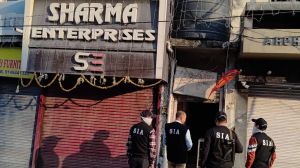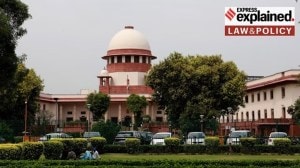Bitter secular-intellectual family feud over Nehru Memorial
For historians,the Nehru Memorial Museum and Library in Delhi has been an institution of unique importance....
For historians,the Nehru Memorial Museum and Library in Delhi has been an institution of unique importance. Many of the most distinguished have been Fellows here,even more put in hours in the library as young researchers. And 57 of them have put their names to a letter asking the Prime Minister who,as Culture Minister,supervises the NMML to intervene in its functioning claiming the centre has precipitously declined.
With signatories like Partha Chatterjee,Sumit Sarkar,Mushirul Hasan,Geeta Kapur,Veena Das,and Sanjay Subrahmanyam,the letter has set off a storm in the intellectual establishment. More so,as it comes just weeks before the end of the term of NMML director,historian Mridula Mukherjee.
The signatories,unofficially led by historian Ramachandra Guha,want Mukherjee,and the particular faction of a particular department of a particular university in New Delhi insiders code for the moderate,Congress-loving section of the Left in JNUs History department out.
Out of the scholarly Everest of the NMML,out of academic power. The signatories themselves form an unexpected coalition: those,like Sumit Sarkar and Nivedita Menon,seen as more radical than the mainstream nationalist left from JNU usually identified with Mukherjees co-author Bipan Chandra making common cause with those,like Mukul Kesavan,Devesh Kapur and Sunil Khilnani,more traditionally Nehruvian and centrist.
The petition is ludicrously fanciful, Mukherjee told The Indian Express from Paris. No,says signatory Rukun Advani. It raises an important question about institutions under the Congress and the UPA: will they be run by loyalists? Or will they be centres of excellence? What is the UPAs intellectual direction?
Mukherjees supporters say the motives arent as grand as that. Its a desperate grab for power, said one of them.
The letter cites four objective indicators to claim that NMML is in decline under Mukherjee. The Indian Express investigated these claims:
•First: Since 2006,not a single publication has emanated from the NMML; an academic journal and the seminal Occasional Paper series were shut down. Books are certainly no longer published by the Nehru Memorial but work done at the NMML has been published instead by Oxford University Press (OUP) and Pearson.
Fellows,and others interviewed,see this as a good move: one frequently-made comparison was the Indian Institute of Advanced Study in Shimla,which insists that work be published in-house but which has no marketing apparatus,so its published,but seldom read.
The journals and paper series were stopped,claims NMML,because of numbers: the journal,started in 2001,never sold more than 62 copies,even when free. But the NMMLs argument is clearly spurious. Journals and papers are never bestsellers and no attempt was made to put them online,where they would certainly have been read widely.
Further,the journal was not peer-reviewed,as is customary,and its quality consequently suffered. More than one of the petitions signatories,when pressed,could not remember a single article from the excellent journal.
The Occasional Paper series,meanwhile,appears to have been replaced many years ago by a series of NMML Monographs,attempts at finished articles,not the usual works-in-progress.
Again,the reason stated was numbers,but actually was concerns about content. Mukherjee now admits as much: Im an academic first. My name shouldnt be associated with substandard stuff. Reading the (14) monographs produced adds substance to the argument that they were extremely variable in quality.
Further confirmation is available from studying citation indices; unlike the frequently cited Occasional Papers,the recent Monographs have practically never been used as scholarly references.
The monographs are to be replaced with the revived original series and Mukherjee also wants them them online,not snazzily printed at the NMMLs expense. So why was that not done in three years?
For the papers,it is claimed that output depends on the academics who have been selected as NMML fellows.
The new batch,Mukherjee promises,the first in the selection of which she had some say,are going to be properly productive. As for the journal,she didnt want one produced until she can hire an editor. (The last one was produced by a junior researcher,she said. On an average,a reasonable journal has several full-time employees.)
•For many of the petitions signatories,the next objective indicator is the central problem: the reference collection.
Researchers,old and new,worry about gaps in a once-legendary collection. Delhi Universitys Mahesh Rangarajan points out that there isnt even a committee to select new books any more,signifying an autocratic style of functioning.
Mukherjee says that committee meetings consisted of selecting books from an ad hoc tray of new books delivered by local booksellers; she didnt think that had accountability,so she hired someone to oversee acquisition by looking through academic book reviews and catalogues of Indian publishing houses.
Her claim is that the library didnt have,earlier,the complete recent history output of OUP,Sage and Permanent Black; now,some signatories worry it doesnt even have the most obvious recent books from,say,New York Universitys Simon Schama.
•The third objective indicator is staff morale. Morale is generally considered to be a quality both individual and intangible,attributes not usually associated with good objective indicators. The petition states that several dozen consultants have been hired,creating an unaccountable parallel power structure. The relevant number,according to an NMML Executive Council submission,appears to be closer to six.
They are mostly paid well below Rs 20,000 a month; Mukherjee says she depends on consultants because rules havent allowed her to make even one appointment from within the system. But that a parallel structure has been created is undeniable,according to staff interviews. Whether it is more or less accountable than the structure in which everyones a permanent government employee is debatable.
•Finally,the petition alleges that plurality of thought is denied at the centre. Studying a list of public lectures,its clear there is a significant overlap between those with those invited to speak at the NMML and those the director knows and has worked with a group anti the BJP,sympathetic to the Left,but not of it.
Of the 17 book discussions since Mukherjee took over in August 2006,11 were mainstream academic histories but nine of those were written or edited by those seen as close to the particular faction in the Centre for Historical Studies at JNU two of the the books were by Bipan Chandra himself. Of the 21 talks during the period,only five were by Indian historians and four of them are considered as allies of that faction.
An accusation that the NMML is now identified with the Congress is more difficult to answer. But,again,the specific complaints are less weighty: one,that the librarys foyer contained photographs of Congress prime ministers,appears to mean,according to several library users,that it held the leftovers of an museum exhibition celebrating fathers and daughters and hence pictures of Jawaharlal with Indira. Then there is the occasion that space in Teen Murti,available for hire,was given out to Rahul Gandhi to address Youth Congress functionaries about the nuclear deal,infuriating many. Some of whom didnt like the idea of Rahul Gandhi lecturing in Teen Murti,and others who disliked the thought of the nuclear deal polluting the spiritual home of Panchsheel and NAM.
(PART II: Why the petition? Whos signed it? And why?)



- 01
- 02
- 03
- 04
- 05




























